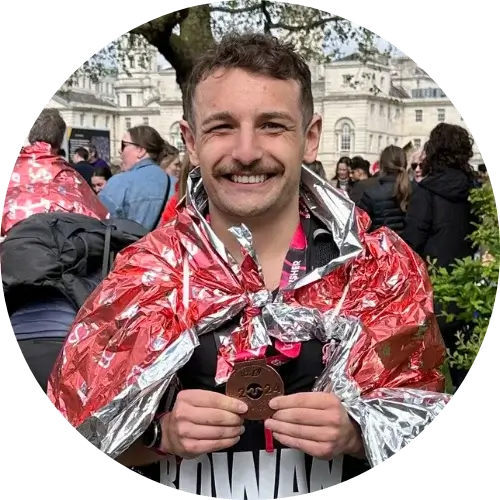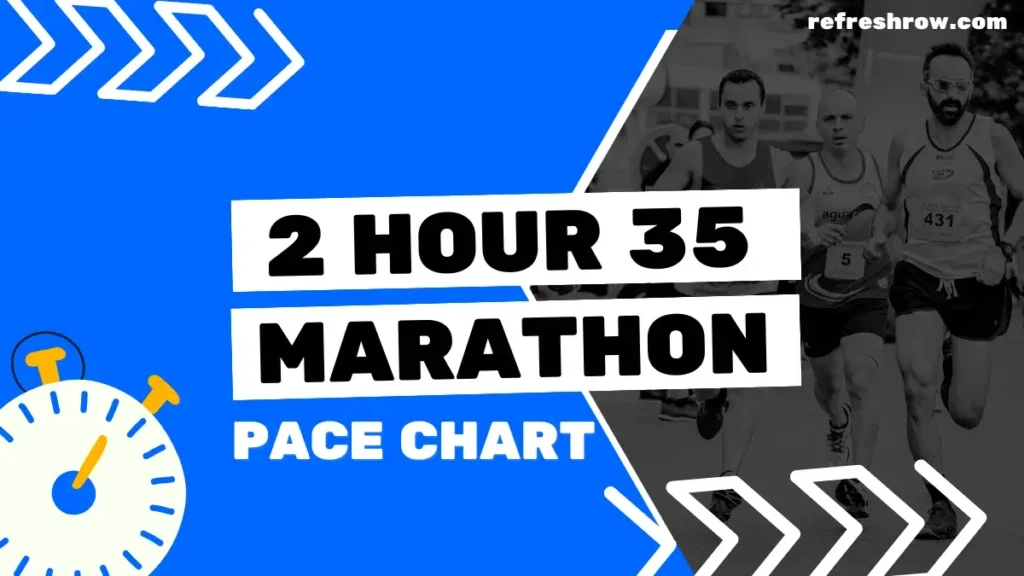To run a 4:00 hour marathon you need to run at a pace of 9:09 per mile or 5:41 per kilometer.
Following the splits below (and shaving off a second), you’ll run a sub 4:00 marathon.
I’d recommend aiming to run 1-2 minutes ahead of the split target time from 10 miles, as you’ll likely come up against crowding on race day.
4:00 Marathon Pace in Miles
| Mile | Split |
|---|---|
| 1 | 9:09 |
| 2 | 18:18 |
| 3 | 27:28 |
| 4 | 36:37 |
| 5 | 45:46 |
| 6 | 54:55 |
| 7 | 1:04:05 |
| 8 | 1:13:14 |
| 9 | 1:22:23 |
| 10 | 1:31:32 |
| 11 | 1:40:41 |
| 12 | 1:49:51 |
| 13 | 1:59:00 |
| 14 | 2:08:09 |
| 15 | 2:17:18 |
| 16 | 2:26:28 |
| 17 | 2:35:37 |
| 18 | 2:44:46 |
| 19 | 2:53:55 |
| 20 | 3:03:05 |
| 21 | 3:12:14 |
| 22 | 3:21:23 |
| 23 | 3:30:32 |
| 24 | 3:39:41 |
| 25 | 3:48:51 |
| 26 | 3:58:00 |
| 26.2 | 4:00:00 |
Download
4:00 Marathon Pace in KM
| KM | Split |
|---|---|
| 1 | 5:41 |
| 2 | 11:23 |
| 3 | 17:04 |
| 4 | 22:45 |
| 5 | 28:26 |
| 6 | 34:08 |
| 7 | 39:49 |
| 8 | 45:30 |
| 9 | 51:11 |
| 10 | 56:53 |
| 11 | 1:02:34 |
| 12 | 1:08:15 |
| 13 | 1:13:57 |
| 14 | 1:19:38 |
| 15 | 1:25:19 |
| 16 | 1:31:00 |
| 17 | 1:36:42 |
| 18 | 1:42:23 |
| 19 | 1:48:04 |
| 20 | 1:53:45 |
| 21 | 1:59:27 |
| 22 | 2:05:08 |
| 23 | 2:10:49 |
| 24 | 2:16:31 |
| 25 | 2:22:12 |
| 26 | 2:27:53 |
| 27 | 2:33:34 |
| 28 | 2:39:16 |
| 29 | 2:44:57 |
| 30 | 2:50:38 |
| 31 | 2:56:19 |
| 32 | 3:02:01 |
| 33 | 3:07:42 |
| 34 | 3:13:23 |
| 35 | 3:19:05 |
| 36 | 3:24:46 |
| 37 | 3:30:27 |
| 38 | 3:36:08 |
| 39 | 3:41:50 |
| 40 | 3:47:31 |
| 41 | 3:53:12 |
| 42 | 3:58:53 |
| 42.2 | 4:00:00 |
Download
Other Marathon Pace Charts
Targeting a different time?
Check out the Full Marathon Pace Chart in Miles or KM
Or select a specific finishing time below:
| 3:00 | 4:00 | 5:00 | |
| 3:05 | 4:05 | 5:15 | |
| 3:10 | 4:10 | 5:30 | |
| 3:15 | 4:15 | 5:45 | |
| 3:20 | 4:20 | 6:00 | |
| 3:25 | 4:25 | 6:15 | |
| 2:30 | 3:30 | 4:30 | 6:30 |
| 2:35 | 3:35 | 4:35 | 6:45 |
| 2:40 | 3:40 | 4:40 | 7:00 |
| 2:45 | 3:45 | 4:45 | |
| 2:50 | 3:50 | 4:50 | |
| 2:55 | 3:55 | 4:55 |
Training for a 4:00 Marathon
Is 4:00 a Good Marathon Time?
Well, what do the stats say?
Run Repeat conducted a study that contains 19,614,975 marathon results from more than 32,335 races across the globe, here is how a 4:00 marathon compares against age and gender for the races recorded:
| Overall | You’re faster than 72.2% of all runners. |
| Male | You’re faster than 63.3% of males. |
| Female | You’re faster than 84.1% of females. |
| <20 | You’re faster than 69.1% of under 20s. |
| 20-29 | You’re faster than 66.5% of 20-29 year olds. |
| 30-39 | You’re faster than 66.4% of 30-39 year olds. |
| 40-49 | You’re faster than 70.6% of 40-49 year olds. |
| 50-59 | You’re faster than 80.5% of 50-59 year olds. |
| >60 | You’re faster than 92.0% of over 60s. |
Training Runs and Paces for a 4:00 Marathon
To break a 4:00 marathon you’ll need to do some serious distance in your training, I recommend at least 15 miles (24km) per week.
You’re also going to need to make sure you’ve crossed off these milestones for other race distances:
- A 5k in 25:00 mins
- A 10k in 52:00 mins
- A half marathon in 1 hour 52 mins
Training Paces
| Pace | Mins per Mile | Mins per KM |
|---|---|---|
| Easy | 10:19 | 6:24 |
| Steady | 9:09 | 5:41 |
| 10k | 8:23 | 5:13 |
| 5k | 8:03 | 5:00 |
| 1 Mile | 7:28 | 4:40 |
Weekly Mileage Targets
| Target Mileage: | Gradually increase your weekly mileage from 25 miles (40 km) to a peak of 45 miles (72 km). |
| Incremental Increase: | Increase mileage by approximately 10% each week, with every fourth week as a recovery week where mileage is reduced by 20-30%. Make sure to taper for the last 1-2 weeks. |
Long Run Structure
| Total Distance: | Build up to long runs of 20-22 miles (32-35 km). |
| Segment Example: | First 5 miles (8 km): Easy pace, heart rate 140-150 bpm (approximately 10:45/mile or 6:41/km). Next 1 mile (1.6 km): Fast pace at 7:50/mile (4:52/km). Next 5 miles (8 km): Medium effort, heart rate around 160 bpm (approximately 8:50/mile or 5:29/km). Repeat: Repeat the segment twice (5 miles easy, 1 mile fast, 5 miles medium), you can taper the final 2 miles if required. |
Why This Works: Incorporating varied paces within long runs enhances lactate tolerance, which helps on race day when you’ve got to maintain pace despite feeling fatigued. By practicing surges during a run, you can build up your physical and mental resilience (lots of elite marathon runners use these strategies during their training)
Alternating Long Runs: Alternate between structured long runs (easy/fast segments) and easier long runs. For easier long runs, maintain a steady, comfortable pace throughout, focusing on mileage rather than speed to aid recovery.
Speedwork Sessions
| Short Intervals: | – 800m repeats at 3:45 per interval (4:41/km). – Aim for 6-12 repetitions with equal time for recovery. |
| Mile Repeats: | – 1 mile repeats at 7:50 per mile (4:52/km). – Aim for 6-12 repetitions with a 1-2 minute recovery jog. |
| Longer Intervals: | – 2 mile repeats at 8:00 per mile (4:58/km). – Aim for 5-8 repetitions with a 2-3 minute recovery jog. |
Recovery and Rest Days
| Rest Days: | You don’t need to incorporate rest days if you are using recovery runs, but I recommend taking 1 (or a max of 2) per week to allow your body to recover and prevent overtraining. |
| Easy Run Days: | Include 1-2 easy run days per week at a relaxed pace of 11:00/mile (6:50/km), covering 5-10 miles (8-16 km) per day. Try to keep your heart rate below 140 bpm on easy days to ensure proper recovery and aerobic development. |
My Tips to Run a Sub 4:00 Marathon
Build a Strong Aerobic Base
To help make your training and race feel more comfortable, focus on building a strong aerobic base early doors.
For me, this consists of dedicating the first few months of your training to slow, steady miles that help develop your cardiovascular system and muscular endurance.
These runs should be at a conversational pace, allowing your body to adapt without excessive strain.
This helps to build the foundations and create a solid platform for the more intense training to come, making those faster-paced workouts and long runs much more manageable.
Train for Negative Splits
Negative splits (where the second half of your marathon is faster than the first), was a game-changer in helping me to bring down my marathon time.
This approach conserves energy during the early miles when adrenaline is high, and it allows you to finish strong, passing other runners who may have gone out too fast (which always helps to give you a little go boost).
Practice negative splits during your long runs and even some tempo sessions by starting at a controlled pace and gradually increasing your speed.
The hardest part of this strategy is pacing discipline, but if you can get it down, it’s going to have a significant impact on your time.
Perfect Your Race-Day Nutrition
Dialing in your race-day nutrition is crucial, especially when aiming for your best time yet.
Through trial and error, I learned the importance of practicing my fueling strategy.
I found the things that really didn’t work well for me (even having to stop half way through long runs), but also those that did.
Experiment with different gels, chews, or sports drinks to see what your stomach tolerates best.
Make sure to consume carbohydrates consistently throughout your long runs to mimic race conditions.
When it comes to marathon day, stick to what you know works for you, and don’t try anything new.
Proper fueling can prevent the dreaded “wall” and keep your energy levels steady for the entire race.
The Art of the Taper
My last tip, but maybe the most important is “don’t overlook/forget the taper phase”, it’s an essential part of your marathon preparation, even if it comes right at the end.
During the final two to three weeks before the marathon, gradually reduce your mileage to allow your body to recover and build strength for race day.
Resisting the urge to push hard during this time can be really difficult, as your brain tells you “surely a few extra miles can’t hurt”, but it will, don’t fall for it.
Focus on staying loose, getting plenty of sleep, and maintaining your nutrition.
The taper is your time to rest and recharge, so when race day arrives, you’re physically and mentally ready to perform at your best.


Row Brown is the founder of Refresh Row. He is a keen marathon runner, his favorite being the London Marathon. He’s now set himself the mission of Running the Entire Length of Spain, which is scheduled for late 2024.


